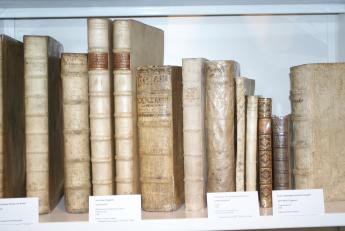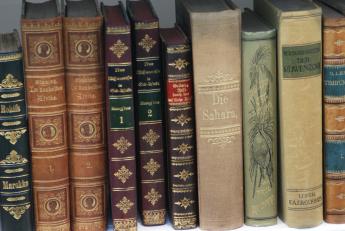The Australian and New Zealand Association of Antiquarian Booksellers
Bookbinding and Collection Maintenance

Newbold & Collins Bookbinders
Around January and February collectors may find one or two, sometimes more of their leather books with broken joints. “It just happened, it wasn’t like that last time I looked”. Extremes in temperature can make a book’s structure change and flex. A warping board, ever so slight, bending one way in a higher temperature and then returning to normal as the temperature drops overnight, can cause old and fragile leather to fracture with the outcome being a detached board.
Equally damaging are damp and humid conditions, causing the paper to swell and buckle as it draws in the moisture, and returning to normal as the weather conditions become dryer.
All these uncontrolled movements in the book’s structure are working away, flexing that fragile leather joint and damaging that valuable or much loved treasure. This usually happens to smaller books in your collection where thinner or pared down leather was used but it occurs with larger books as well.
The preventative solution is to control the environment where your books are stored, and to maintain constant temperature and humidity levels.
For many problems with your books it is best to find a competent bookbinder who is able to offer services in repair, rebinding, conservation binding, refurbishing, paper repair and make boxes. Above all, do choose a bookbinder who offers sound and honest advice on maintaining your collection.
Whether it be minor or major attention that is needed, it is up to the present custodians to have this attended to by experienced and competent people.
Selecting a bookbinder to help in the maintenance of your collection is important and this is usually accomplished through recommendations by dealers, fellow collectors or institutions who use outside bookbinders in maintaining their major collections.
Once you have found a binder, establish a partnership and make sure that only the best and appropriate materials are used and that you are in agreement with any decisions made about your books.
Your binder should have a good knowledge of the history of book structure and book design as well as the history of the materials used. He will probably have a good collection of hand finishing tools to be able to replicate the design on the book cover. Above all he will adhere to archival principles and have a practical approach along with his skill.
Rare and antiquarian books or those of purely sentimental value will benefit from sympathetic repair whether major or minor in nature. This will ensure that a broken or damaged volume remains intact whilst remaining serviceable and also last for another generation to enjoy.
The article by Newbold & Collins was first published in the “ANZAAB Aspects of Book Collecting” on www.anzaab.com, and is presented here, with our thanks, by permission of the ANZAAB.
The Unavoidable: The Restoration of Books - More about book binding and book restoration by Geneviève von Hahn

